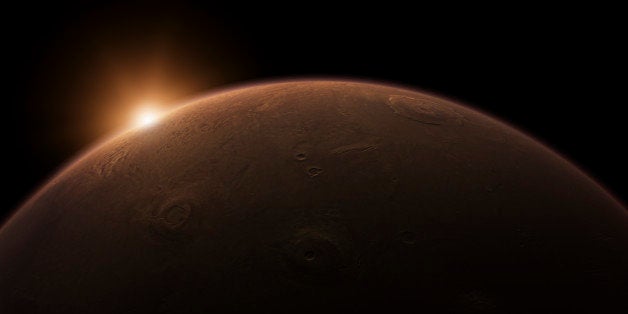
Every time NASA ballyhoos a press conference to announce an exciting discovery about Mars, the public bets heavily that the news will either be about water (What, again?) or life (Finally!)
This week's communique is about both, and neither. But there's no gainsaying the fact that it's exciting.
It concerns the seasonally changing features on crater walls and other vertical topography, known as recurrent slope lineae. These things look like long, dark fingers running downhill, and they become prominent when summertime Mars warms up to temperatures that, while cold for Earth, are considered balmy on the Red Planet.
The lineae resemble seepage - melt water just below the dry, Martian surface that's oozing its way downhill. Now, researchers using spectral analysis from an orbiter have determined that it most likely is water - not any of the other possible phenomena. That's a strong indicator that there are subsurface reservoirs at very shallow depth on Mars. In other words, Mars apparently has lakes today; they're just covered by a rusty, dusty carapace of boring dirt.
Now many astrobiologists think that the Red Planet was once a kinder, gentler world. Three or four billion years ago or thereabouts, Mars may have had occasional rivers, lakes and even oceans on its surface. The canyons and lakebeds are all dry as dandruff today, but given the ubiquity of the lineae, subsurface aquifers could still be present in abundance.
And so the scenario is as obvious as it is compelling: In its youth, Mars may have actually spawned single-celled life. As conditions slowly deteriorated, this life adapted to whatever environments were still around - including within the pitch-dark, subsurface aquifers. It could still be enjoying a cryptic lifestyle today.
Knowing this, how might we find these microscopic Martians? NASA tried looking for life on the Red Planet in the 1970s with its highly sophisticated Viking landers. But the experiments had limited sensitivity, and the results - at least according to some - were ambiguous.
The lesson learned? Hunting for extant life is difficult. After all, you have to look in the right place. And of course there's also the sobering possibility that biology is entirely past tense on the Red Planet. It's dead, Jim.
Consequently, for years the space agency has adopted a more promising tactic. Better, it figures, to first learn more about the history of the Red Planet, and pinpoint places where life could have once existed. After all, in any reasonable scenario involving Martians, there's got to be a lot more dead life than extant life. Living critters don't pile up, but dead ones do.
That's why the Curiosity rover, now making its way up Mount Sharp at the center of Gale Crater, is hoping to unravel the geologic history of Mars - not to look for life itself. Its job is to see if there are places where biology may have once existed.
But NASA's announcement that the lineae are most likely wet streaks due to salty, subsurface water could change the game plan. They are like signs on Treasure Island, screaming "dig here!"
And while future spacecraft will undoubtedly try to do that, there's a chance for more immediate action. Jim Green, NASA's Planetary Science Division Director, told me that there could be some of these lineae on Mount Sharp, and possibly accessible to Curiosity. That's a seductive, and unexpected diversion for the plucky rover.
Today's news suggests that underwater aquifers - refuges where microscopic Martians might wiggle and float - may underlie much of the planet, like a layer of subcutaneous fat. This may greatly increase the incentive to switch our efforts on Mars from looking for habitats where life might have once thrived, to exploring habitats where it might be thriving today. Just drill down a very short distance into the wet and muddy basement of the dry Martian landscape, and look for life.
Instead of counting on biology from 3 billion years ago that's well-and-truly dead, this news about the true nature of the perplexing Martian lineae urges us to discover what centuries of peering at the Red Planet with telescopes and orbiters was never able to do: Find the Martians.